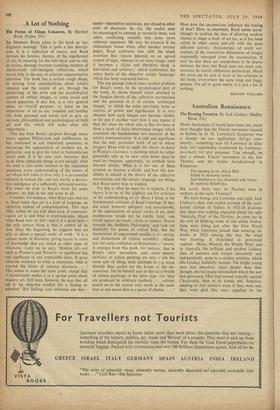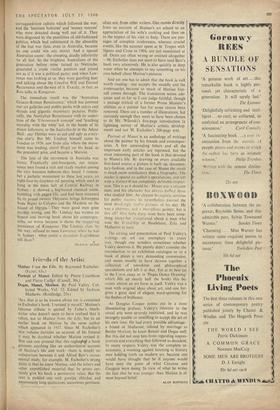Australian Renaissance
MANY Australians (I would have been one, once) have thought that the Fascist movement located in Sydney in D. H. Lawrence's Kangaroo was a slander on our egalitarian, fair-go com- munity: something seen by Lawrence in alien Italy and improbably transferred by Lawrence- in-a-hurry for plot purposes. True enough, we had a minute Fascist movement in the late Thirties, and the battles foreshadowed in Kangaroo:
The meeting in the Adyar Hall Ended in unseemly brawl , And Stephenson was showered with bricks By patriotic Bolsheviks.
But surely there were no Fascists, even in embryo, in the early Twenties?
We were wrong, and Lawrence was right. Jack Lindsay's clear and candid account of the intel- lectual climate of Sydney in 1921-26 discloses that there was nothing imported about the ugly 'Australia First' of the Thirties: its roots lay in the sort of thinking some of our ablest Austra- lians were doing just after the First World War, when Lawrence passed that amazing six weeks in 1922 sensing the way the wind was blowing. It flourished in provincial capitals: Milan, Munich, the Middle West; and in Australia the brilliant and strident Lindsay clan of painters and writers innocently and independently came to a similar position, which this Lindsay faithfully records. The bright young men had absorbed, more deeply than they thought, the hot-house nationalism which the war had generated. They had turned radically against Christianity, then at its lowest ebb. Sensitive, needing to feel sensitive even if they were not, they were glad they were appalled by the corrugated-iron culture which followed the war, and the 'business baboons' and 'money morons' who were detected doing well out of it. They were disgusted by the puerilities of old-fashioned politics, which had culminated in the absurdity of the lost war (lost, even in Australia, because no one could win any more). And a special Australian cause: the creeping, deadly inferiority we all feel. So the brightest Australians of the generation before mine turned to Nietzsche, generated a crude vitalist position and joined sex as if it was a political party; and when Law- rence was looking at us. they were guzzling beer and talking about the Creative Will and Eternal Recurrence and the .rest of it. Exactly, in fact, as Roo talks in Kangaroo.
The immediate result was the 'Australian Graeco-Roman Renaissance,' which has jammed our art galleries and public parks with satyrs and dryads and gigantic mammary pictures. Politi- cally, the Australian Renaissance with its under- tone of the `Uberniensch concept' and 'teaching morality with the whip' led, in the hands of its minor followers, to the Saalsehlacht in the Adyar Hall: our Thirties were as sad and ugly as every- one else's. But Mr. Lindsay himself came to London in 1926, saw from afar where the move- ment was leading, stood Hegel on his head, as the precedent wits, and became a Marxist.
The fate of the movement in Australia was ironic. Frantically anti-bourgeois, our renais- sance men found a rich and ready market among the very business baboons they hated. I remem- ber a pathetic monument to these lost years, an eight-foot-by-fourteen oil painting which used to hang in the main halt of Central Railway in Sydney: it showed a big-busted classical scene, bubbling with pagan life, and had been renamed by, its proud owners 'Odysseus brings Schweppes Soda Water to Calypso and the Maidens on the Island of Ogygia.'l They were good men gone terribly wrong, and Mr Lindsay has written an honest and moving book about his contempor- aries, no worse because it shows the stageering prescience of Kangaroo. The Lindsay clan, by the way, refused to meet Lawrence when he was in Sydney : what could a decadent Englishman
MURRAY SAYLE



































 Previous page
Previous page